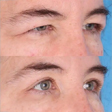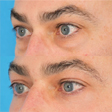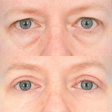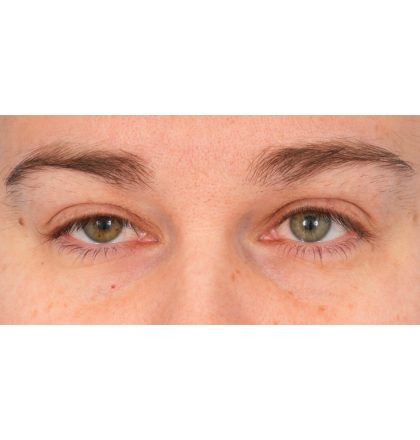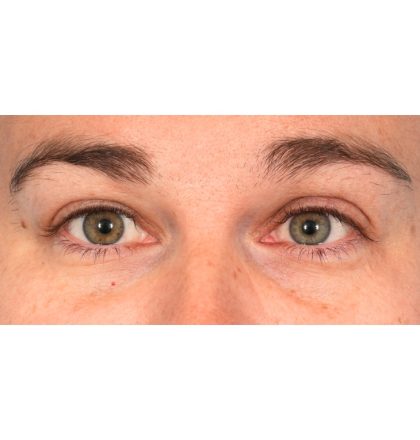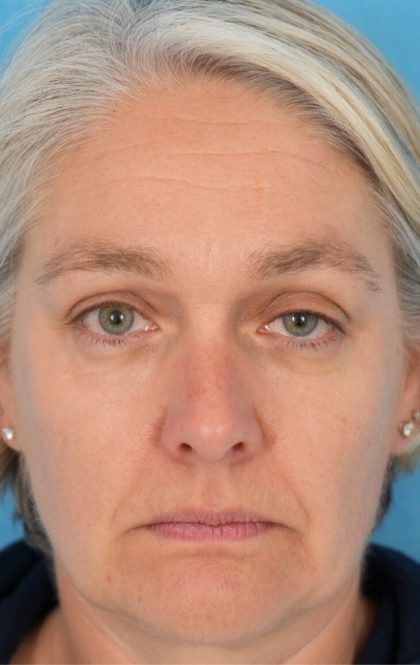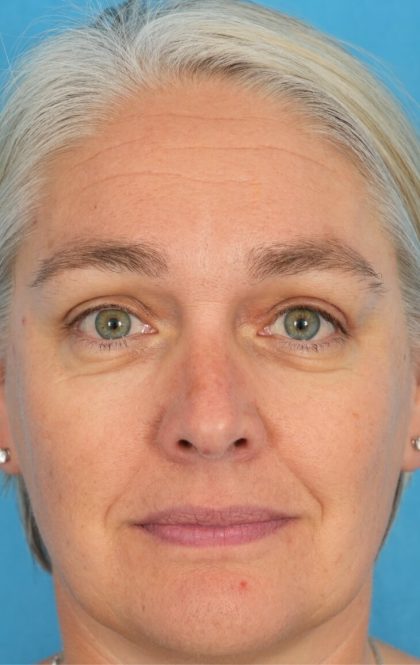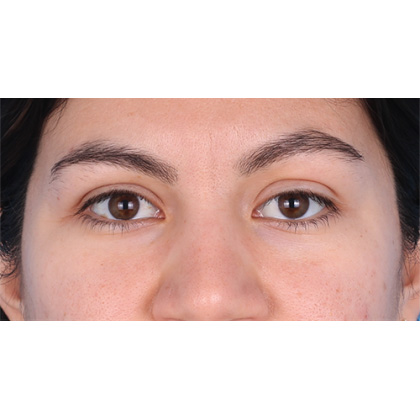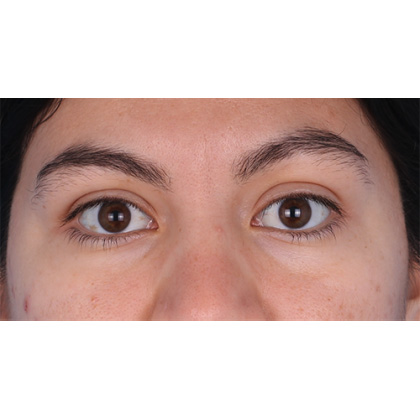Ptosis Repair
Conveniently located to serve the areas of Chicago, IL

Ptosis, commonly known as droopy eyelids, is a condition characterized by the sagging of one or both eyelids. This can be due to congenital factors, neurological or muscular issues, or simply aging. Consulting with a specialist is crucial for pinpointing the cause and exploring treatment options. Ptosis repair surgery aims to raise the eyelid by tightening muscles in the eyelid, enhancing the eyelid appearance and symmetry. Asymmetry of the eyelid position at rest is the most sensitive facial feature. (1) As we age, decreased elastin and collagen levels in eyelid tissues decrease leading to droopiness, which can obstruct vision and hinder daily activities. In some cases, your eyelids can obstruct your vision and affect your ability to drive or perform daily tasks. If the eyelid touches the pupil it may even be causing significant visual impairment. (2) Ptosis repair may not only improve eyelid appearance, making them look more alert and symmetrical but may also enhance vision and daily function.
Dr. Paul Phelps is an oculofacial surgeon at Chicago Oculofacial Plastic Surgery who specializes in ptosis repair and has even written several articles on eyelid asymmetry and ptosis repair. He can help you improve your appearance with eyelid surgery. Treatment may improve your quality of life. How you feel about your appearance can affect every aspect of your daily routine. Contact our office or call (312) 888-5754 to talk to our team about how we can help you.
Contents
Before and After Photos
About Ptosis Repair
Ptosis is the medical name for sagging. Ptosis repair corrects weak muscles that impact your self-esteem and quality of life. During the procedure, Dr. Phelps can tighten the tissues and restructure your underlying muscles for a youthful, more energetic look. As gravity pulls on the skin, the fat in your face atrophies, and your skin loses essential structural support from declining collagen, it is common to see the shape and contour of your face begin to change. (3) Ptosis repair is an effective way to achieve a more open appearance.
Addressing facial aging is not just cosmetic– wrinkles and lines that affect your daily expressions can cause you to look angry or tired. Droopy skin and furrowed brows from aging can even result in miscommunications that affect the quality of your relationships and life. (4) To schedule a consultation or inquire about ptosis repair, please contact Chicago Oculofacial Plastic Surgery at (312) 888-5754.
What is Blepharoplasty?
A blepharoplasty improves the appearance of your eyes for a more refreshed look. During an upper blepharoplasty, Dr. Phelps can remove droopy skin from the upper eyelids to improve your field of vision and rejuvenate your appearance. He can help you achieve a smoother under-eye area with a lower blepharoplasty that repositions the fat pads beneath the eyes for a more awake appearance. During a quad blepharoplasty, he can perform both procedures during one appointment.
Types of Eyelid Ptosis Repair
There are various surgical techniques utilized for eyelid ptosis repair:
- Levator Muscle Resection: This is the most common method where the levator muscle is tightened, allowing the eyelid to lift properly.
- Frontalis Sling Procedure: For individuals lacking sufficient muscle strength, a sling made of non-absorbable material is attached to the eyebrow area to assist in elevating the eyelid.
- Müller’s Muscle Conjunctival Resection: This method targets Müller’s muscle for smaller corrections, often resulting in a less invasive approach.
Each technique has distinct advantages, thus the appropriate choice is determined based on individual needs and characteristics assessed during the consultation.
Ptosis Repair Benefits
Ptosis repair offers numerous advantages for individuals with droopy eyelids. Some of the key benefits include:
- Improved Vision: By elevating the eyelids, patients experience an enhanced field of vision, especially in the peripheral areas.
- Enhanced Appearance: We can help you achieve a more youthful look by eliminating droopy eyelids that create a tired appearance.
- Increased Confidence: Patients report enhanced self-esteem after the procedure which can also improve personal and professional relationships.
- Personalized Treatment Plans: Each treatment is tailored to individual needs, ensuring that aesthetic goals align with anatomical considerations.
- Long-Lasting Results: Patients can enjoy long-lasting benefits if they take good care of their skin and lead a healthy lifestyle.
- Minimal Scarring: Incisions are strategically placed to remain discreet and hidden within the natural folds of your skin.
- Quick Recovery: Most patients can return to normal activities relatively quickly following proper healing.
- Customizable Procedure: Combining ptosis repair with other procedures can help you achieve your goals and maximize the outcome of the treatment.
Ptosis Repair Candidates
Candidates for ptosis repair include men and women of all ages who are experiencing droopy skin on the eyelids. Suitable candidates are in good overall health and realistic about the results they can achieve with the procedure. They would like to achieve a younger appearance, reduce droopy skin, and tighten their skin for a smoother look. If you have a condition that could affect your ability to heal from the procedure, we will likely recommend an alternative. During the consultation, Dr. Phelps will evaluate your health history and examine your skin to determine the best treatment plan for your needs.
Consultation
During your consultation, Dr. Phelps will review your medical history and discuss your aesthetic goals. He will create a treatment plan based on your unique anatomical features and develop a customized plan for your needs. He will make careful adjustments to your skin to help you maintain proportional balance and emphasize your best features. Please come prepared to discuss any questions you have about the procedure. If you have photos of the look you would like to achieve, Dr. Phelps can examine them during your appointment.
How to Prepare for Ptosis Repair
You may need to make a few adjustments to your routine and lifestyle before your procedure to ensure the best outcome. We will provide specific instructions to help you prepare for your procedure, and it is important to take the following steps:
- Stop taking blood thinners to prevent excessive bleeding.
- Cease nicotine use, which can compromise healing processes.
- Make arrangements for transportation home after surgery.
- Set aside sufficient time off from work and other commitments for rest.
- Prepare your meals ahead of time.
- Create a comfortable place in your home to recover.
Dr. Phelps will need to make adjustments to your skin, so you must avoid excessive sun exposure and any activities that could damage your skin before the procedure. Taking good care of your skin before and after the treatment can help you heal more quickly.
Ptosis Repair Procedure
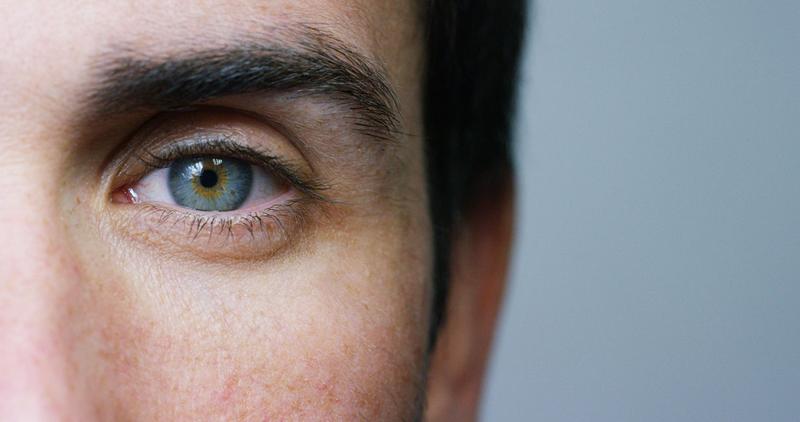
The ptosis repair procedure typically takes 1 to 2 hours, depending on individual requirements and complexity. After we administer anesthesia, Dr. Phelps will cleanse and mark your skin for the procedure. He will make delicate incisions along the natural folds of your eyelids to remove droopy tissue, make the necessary tissue adjustments, and close the fine sutures. The incisions are discrete and they are designed to blend into your skin over time. After the procedure, the surgical team will monitor for a brief period before you are discharged and can return home.
Ptosis Repair Recovery
After surgery, you can expect some swelling, bruising, and mild discomfort. Dr. Phelps can prescribe medications to help you manage the pain for a more comfortable recovery. To help your body heal, you will need to elevate your head for several weeks and prevent bending over with your head below your knees. You can use a cold compress to reduce any swelling and discomfort after the procedure. Dr. Phelps will let you know when you can follow up with him so he can monitor your progress. Most individuals can return to routine activities within a week, though strenuous activities should be avoided for several weeks until cleared by Dr. Phelps.
Results
You can enjoy results from eyelid ptosis repair in a few weeks after the swelling subsides. You can enjoy eyes that look more open and awake, leading to a refreshed and alert look. Patients often see significant improvements in both their vision and aesthetics. Scars are typically minimal, as they are located along the natural creases of the eyelids.
Cost of Eyelid Ptosis Repair in Chicago
The cost of ptosis repair varies considerably based on individual factors, including the complexity of the case. We can provide a detailed estimate during your initial consultation after Dr. Phelps assesses your skin. Investing in your appearance and well-being can transform how you feel in everyday life and boost your confidence immensely. Do not hesitate to contact our office or call (312) 888-5754 to schedule your consultation.
FAQ
What causes ptosis?
Ptosis can result from aging, congenital factors, nerve damage, or trauma to the skin. Weakness or muscle atrophy from aging can also cause droopy pockets of skin to form.
Is ptosis repair painful?
Since ptosis repair does require incisions, some patients experience discomfort while their skin heals. However, most patients report only mild discomfort that they can alleviate with medication and a cold compress.
How long will the recovery take?
While many patients return to most activities within a week, complete healing may take several weeks depending on the severity of your ptosis and the type of procedure you have.
Will I have visible scars?
We take care to place incisions along the natural folds of your eyelids to minimize scarring.
Can I combine eyelid ptosis repair with other treatments?
Yes, you can combine ptosis repair with additional procedures such as a facelift or a brow lift, and we can discuss your goals during your consultation to determine the best treatment plan for your needs.
References
- Wang TT, Wessels L, Hussain G, Merten S. Discriminative Thresholds in Facial Asymmetry: A Review of the Literature. Aesthetic Surgery Journal. 2017;37(4):375-385. doi:https://doi.org/10.1093/asj/sjw271
- Cahill KV, Bradley EA, Meyer DR, et al. Functional Indications for Upper Eyelid Ptosis and Blepharoplasty Surgery. Ophthalmology. 2011;118(12):2510-2517. doi:https://doi.org/10.1016/j.ophtha.2011.09.029
- Ganceviciene R, Liakou AI, Theodoridis A, Makrantonaki E, Zouboulis CC. Skin anti-aging strategies. Dermato-Endocrinology. 2012;4(3):308-319. doi:https://doi.org/10.4161/derm.22804
- Swift A, Liew S, Weinkle S, Garcia JK, Silberberg MB. The Facial Aging Process From the “Inside Out.” Aesthetic Surgery Journal. 2020;41(10). doi:https://doi.org/10.1093/asj/sjaa339
